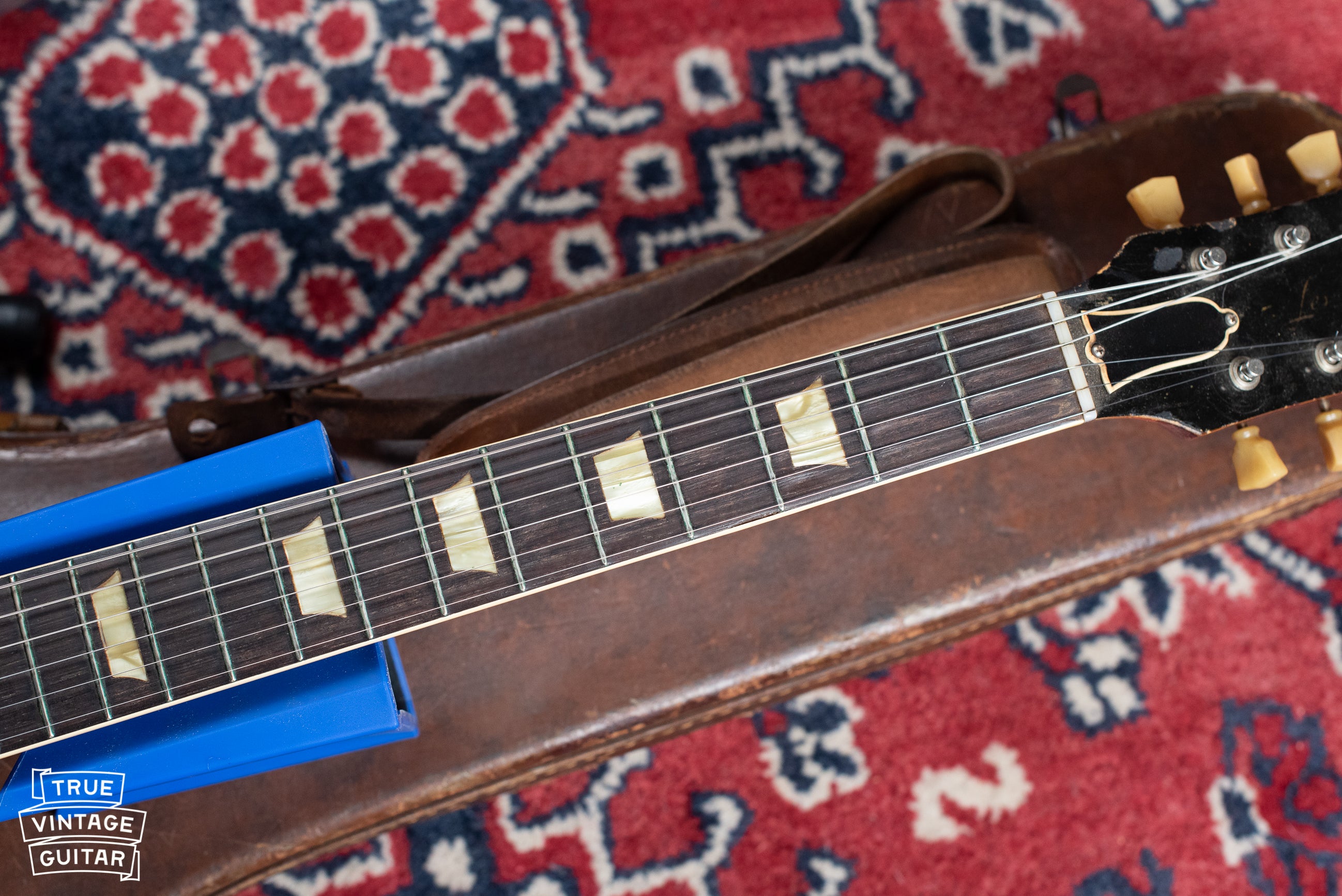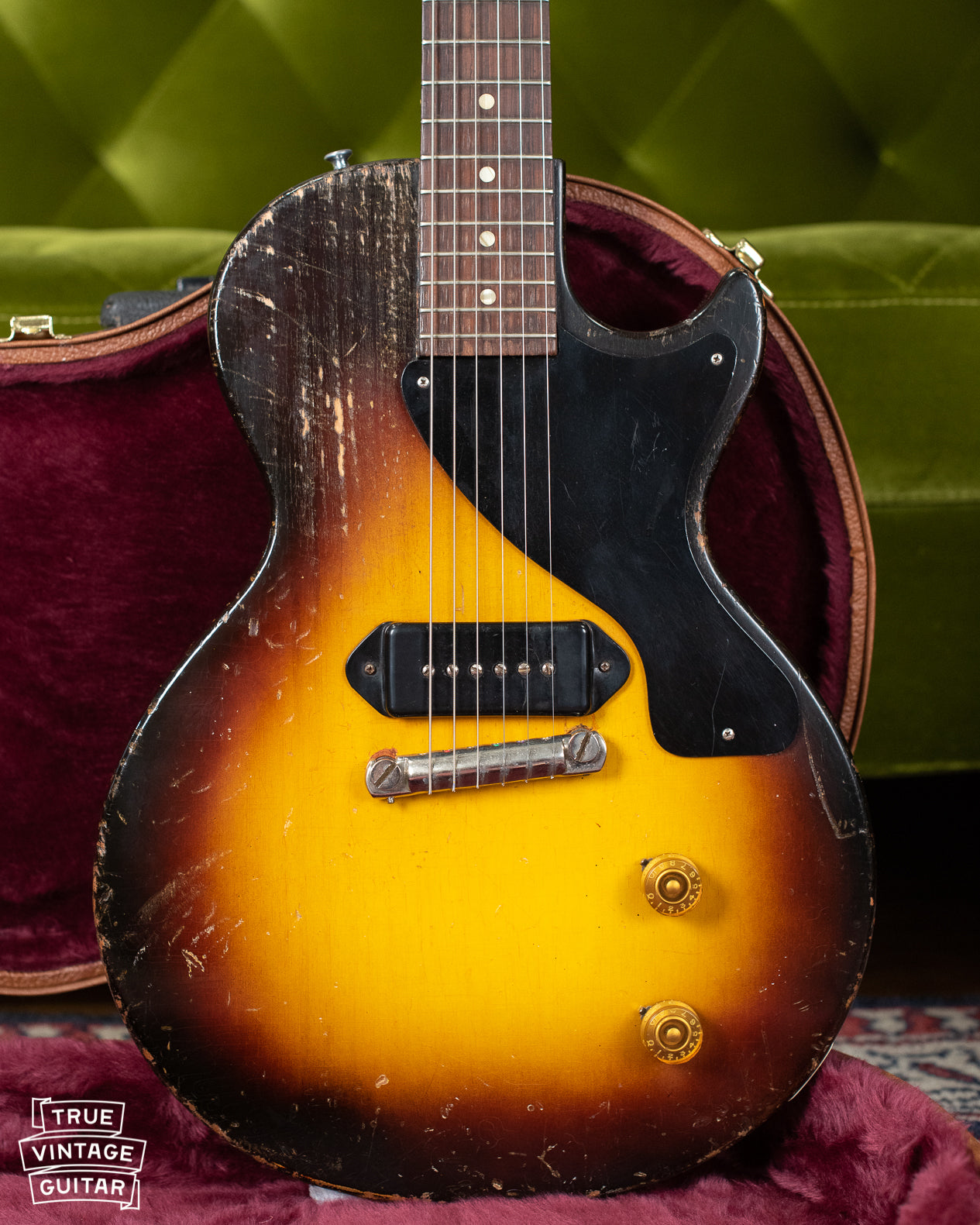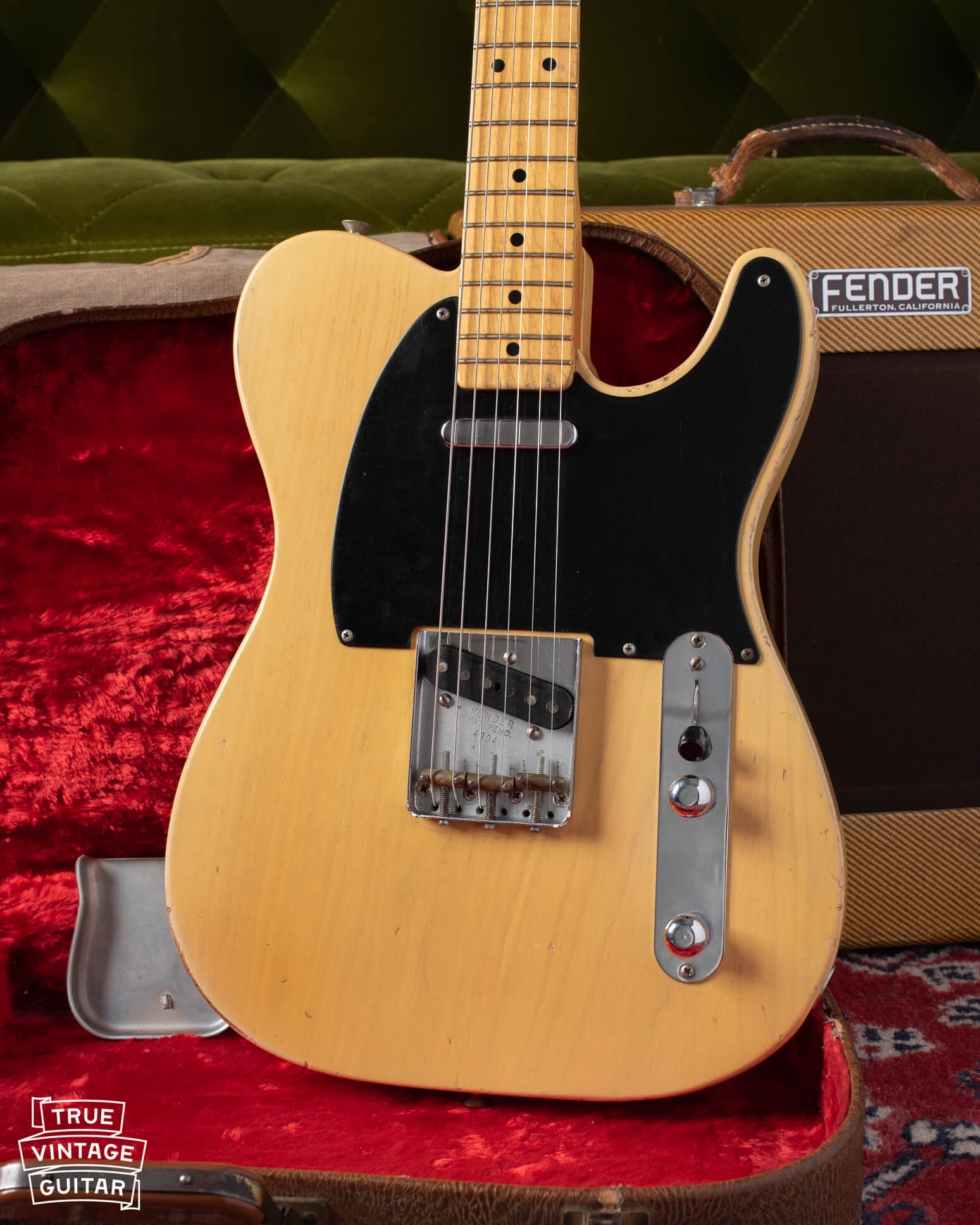Gibson's Les Paul Standard was at its peak during the transitional year of 1958. The classic Goldtop finish that model was introduced with only 6 years earlier was updated to an aggressive but beautiful Cherry Sunburst finish about mid way through the year. Since the top finish was now translucent, the Maple cap seam needed to be centered instead of off to the side like prior guitars. To this author, all of the Les Paul Standards made in 1958 are the pinnacle of production for the model.
I'm always a buyer for vintage Gibson guitars, but I'm especially looking for Gibson Les Paul guitars from the 1950s, 1960s, and 1970s. You can contact me here to sell a Gibson guitar.
If you're looking for help with Gibson guitar dating, check out Les Paul Serial Numbers. Or go here for more information on 1950s Les Paul Values.
How many Les Paul Standards did Gibson make in 1958?
How much is a 1958 Gibson Les Paul Standard worth?
1958 Les Paul Standard I purchased in South Africa "PJ"!
1958 Les Paul Standard Burst I purchased in Norway
1958 Les Paul Standard Goldtop finish and dark back
Considering selling a 1958 Les Paul? Contact the collector: Sell a Gibson.
1958 Les Paul Standard
In my opinion, 1958 is the absolute pinnacle year for the Les Paul line in the 1950s. 1958 was the all important year of the transition from the Goldtop finish of 1957 to the Cherry Sunburst finish you see here with red outside fading to yellow on the inside. The larger humbucking which resisted the buzzing of the 60 cycle hum through an amplifier were introduced only the year before in 1957. The Tune-O-Matic bridge, which intonates more precisely than the wrap tail or trapeze bridge, became standard on the goldtop in late 1955.
 |

|
But Gibson was not finished updating the Les Paul line in 1958. Only a year later in 1959, the Les Paul Standard received a fret size update from skinny 1950s frets to more modern jumbo style frets used throughout the 1960s. Many players prefer the larger frets but I am personally partial to the normal 1950s size skinny frets. They don't last as long as larger frets, but they simply feel better to play in my opinion.
The neck profiles on 1958 Les Pauls are generally standard, although the final shaping was done by hand, so there is some variance to within + or - .02". The neck profile on this flamed out Burst measured about 0.90" deep at the first fret and 1.00" at the 12th fret. The profiles began to slim down to about 0.85"-0.95" in 1959, then all the way down to 0.80"-0.90" in 1960. Of the three standard neck profiles, the large 1958 is my favorite. The larger neck feels comfortable in my hand and is unmistakably vintage. I'll admit that the '59 profile may be easier to play for long periods of time.
How many Les Paul Standards made in 1958?
The best way to determine how many Les Paul Standards were made in 1958 is to use Gibson Shipment Totals: 1937-1979 by Larry Meiners. This book is a printed record of the totals in Gibson's shipment ledgers were are owned by the current Gibson company. You may remember that the day books from Gibson from mid 1958, 1959, and 1960 are missing and that the company is offering a $59,000 reward for their return.
Lucky for us, the totals for each model were recorded in the shipment ledgers from Gibson, not the day books. Gibson's shipment totals indicate that 434 Les Paul Standards were shipped in 1958. Do you have one? Get in touch: Sell a Gibson. The totals do not record how many were Goldtops and how many were 'Bursts.

1958 Les Paul Standard PAF Pickups

|
 |
Of equally important note to the 1958 Gibson Les Paul Standard, Gibson employee Seth Lover helped design a brand new type of pickup in 1955 that replaced its old single coil design, the P-90. The Humbucking pickup utilized two coils with reverse direction windings that cancelled the 60 cycle hum that often plagued the single coil pickups. The Humbucking pickup replaced the P-90 on the Les Paul Model in 1957. It's commonly called the "PAF" pickup because of the sticker on the back that reads "PATENT APPLIED FOR". This is the pickup that helps make the 1958 Gibson Les Paul Standard such a coveted guitar.
1958 Gibson Les Paul Standard from South Africa "PJ"
This 1958 Gibson Les Paul Standard burst, nicknamed "PJ" because of the name on the case, weighed in at 8lbs 14oz. The neck profile measured exactly .90" deep at the first fret. This is a typical fat 1958 profile that I found very comfortable because of the slightly thin shoulders of the C shape. Many of the R8 reissue Les Pauls had more a D shaped neck that felt even larger than they measured. This was not the case with this guitar!

The control cavity of this 1958 Gibson Les Paul Standard had some interesting features that are specific to a 1958 Gibson guitar. Check out the way that the ground wire is soldered to the back of each pot. You can also see the bright yellow lead covers on the capacitors. It seems that Gibson wasn't preoccupied with the direction of the capacitors when installing them since many from this time period are installed opposite of each other, including this guitar. You can also see a pretty nice chew mark on the edge of the cavity. The potentiometer codes read 134 808 which indicates Centralab, 1958, 8th week.


Another interesting feature that's typical of 1958 Gibson Les Paul Standard guitars and even some early 59s is the small fret style. Gibson updated their standard fret size to large jumbo frets in 1959 so there are far more large fret bursts than small fret guitars. This guitar had been played a lot so there was very little meat left on the small frets. It was still a blast to play!
1958 Gibson Les Paul Standard from Norway
|
I've just returned from a guitar buying trip to Oslo, Norway to pick up another 1958 Gibson Les Paul Standard Burst! This Les Paul is less than 200 serial numbers away from the '58 Burst I bought in South Africa. I booked my flight to buy this guitar going on some vague cell phone pictures, so I was pleasantly surprised when I was finally able to open the case and view this amazing guitar. The top color was vibrant and showed very little fading. The figure of the Maple top was busy and interesting, but not book matched like a reissue guitar. It's perfect! |
 |
Are you interested in selling a 1950s Gibson Les Paul? Sell a Gibson.
My new friend in Norway purchased this '58 Gibson Les Paul Standard in 1974 when he saw an acquaintance walking down the street with a brown case in hand. He stopped the gentleman and asked "what's in the case?" The case toting man replied that it was an older Gibson Les Paul Standard, and that he was on his way to show it to someone since it was for sale. After my friend inquired about the price (about $600), he said that there was no need to show it to someone else because he would like to buy it.
 |
Inside the pocket in the brown and pink Les Paul case was a letter that the previous owner received back from Chicago Musical Instruments (CMI), the parent company of Gibson at the time. The letter, dated April 12th, 1972, was written by Helene Blue who was the secretary for A. H. Giel who was the vice president of the company. The previous owner had inquired about dating the guitar and determining how many were made. CMI apparently had absolutely no idea about either answer. Ms. Blue said that she thought that the guitar had possibly been made in 1953! |

1958 Les Paul Standard Goldtop with Bigsby
I'm pleased to share the latest 1958 Gibson Les Paul Standard to come through the shop! This one is an early 1958 Les Paul with dark back and factory Bigsby tailpiece. Take a look closely at the top to see how there aren't any stop bar tailpiece studs installed in the body. Its previous owner bought it used in the 1970s and had Grover tuners installed, a refret with jumbo sized frets, and a brass nut installed. I prefer my vintage Les Paul guitars to have factory equipment as close as it makes sense, so we reinstalled the original tuners and nut which were retained inside the case.

 |

|
This 1958 Goldtop Les Paul also had its original bridge pickup removed at some point. While this doesn't necessarily damage the pickup, it yields no benefit to the guitar and is completely unnecessary. The previous owner didn't reinstall the bridge pickup very nicely, so I removed the solder holding the cover on and started over. Once the original cover solder was reflowed in the way the factory would do it, I aged the solder a bit so that it wouldn't be quite so shiny. I think it's a job worth of such a nice guitar.

Have a 1958 Les Paul? Get in touch
Do you have a 1958 Gibson Les Paul Standard? Congratulations! That's a stunning guitar. You may have questions about proper identification, authentication, and valuation. I am an active collector, dealer, and passionate player of Les Paul guitars from the 1950s. You can contact me here to Sell a Gibson or for help with more information about your guitar.




Comments
Seeing that burst laying in the pink interior case is like looking at an open treasure chest full of gold…
Interesting to see how sloppy the binding was scraped on that goldtop. The reissues of the custom shop are too precise , clinical , cold. No 50s Les Paul was like that when new…..
Consider a trade? I have one left nut.
Gorgeous historical piece